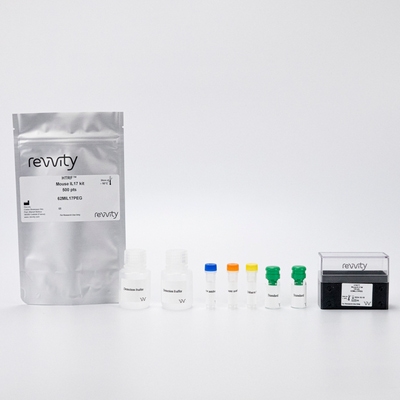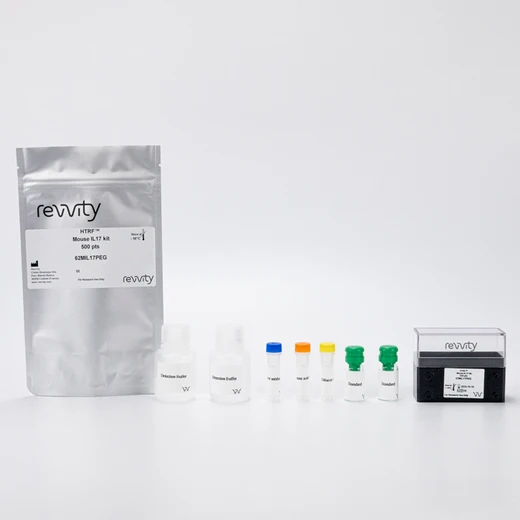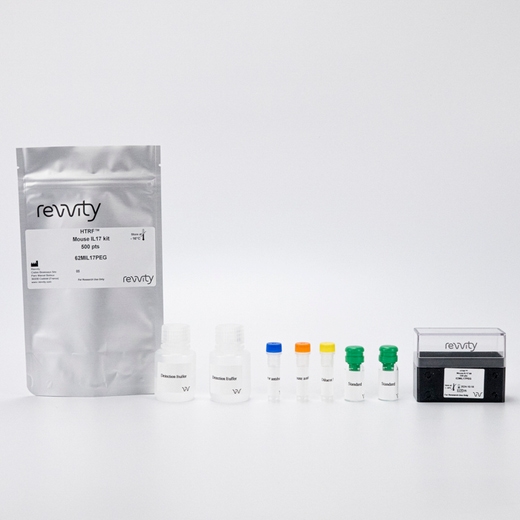

HTRF Mouse IL-17 Detection Kit, 10,000 Assay Points


HTRF Mouse IL-17 Detection Kit, 10,000 Assay Points






The HTRF mouse IL17 kit is designed for the quantification of mouse IL17 release in cell supernatant.
| Feature | Specification |
|---|---|
| Application | Protein Quantification |
| Sample Volume | 16 µL |
The HTRF mouse IL17 kit is designed for the quantification of mouse IL17 release in cell supernatant.



HTRF Mouse IL-17 Detection Kit, 10,000 Assay Points



HTRF Mouse IL-17 Detection Kit, 10,000 Assay Points



Product information
Overview
IL17 is a pro-inflammatory cytokine induced by IL23 and produced by helper T cells. IL17 is part of response to fungi and bacteria, and promotes release of or pro-inflammatory cytokines and chemokines. Due to its role as a mediator of inflammatory responses, IL17 has been linked to allergic responses and autoimmune diseases like asthma, psoriasis, or IBD (inflammatory bowel disease). In immuno-oncology, IL17 is main cytokine released by differentiated TH17 cells.
Assessment of serum samples often requires enhanced sensitivity. In some cases, AlphaLISA assays may have sufficient sensitivity to enable detection of low levels of analytes in serum or plasma. When assaying, always follow recommended protocol and avoid highly haemolyzed samples.
Specifications
| Application |
Protein Quantification
|
|---|---|
| Brand |
HTRF
|
| Detection Modality |
HTRF
|
| Product Group |
Kit
|
| Sample Volume |
16 µL
|
| Shipping Conditions |
Shipped in Dry Ice
|
| Target Class |
Cytokines
|
| Target Species |
Mouse
|
| Technology |
TR-FRET
|
| Therapeutic Area |
NASH/Fibrosis
Oncology & Inflammation
|
| Unit Size |
10,000 Assay Points
|
Video gallery

HTRF Mouse IL-17 Detection Kit, 10,000 Assay Points

HTRF Mouse IL-17 Detection Kit, 10,000 Assay Points

How it works
Assay principle
Cell supernatant, sample, or standard is dispensed directly into the assay plate for the detection by HTRF® reagents (384-well low-volume white plate or Revvity low-volume 96-well plate in 20 µl). The antibodies labeled with the HTRF donor and acceptor are pre-mixed and added in a single dispensing step, to further streamline the assay procedure. The assay can be run up to a 1536-well format by simply resizing each addition volume proportionally.

Assay data analysis
The 4 Parameter Logistic (4PL) curve is commonly recommended for fitting an ELISA standard curve. This regression enables the accurate measurement of an unknown sample across a wider range of concentrations than linear analysis, making it ideally suited to the analysis of biological systems like cytokine releases.
Assay details
Technical specifications of mouse IL17 kit
| Sample size | 16 µL |
|---|---|
| Final assay volume | 20 µL |
| Kit components | Lyophilized standard, frozen detection antibodies, buffers &protocol. |
| LOd &LOQ (in Diluent) | 4 pg/mL &16 pg/mL |
| Range | 16 4,000 pg/mL |
| Time to result | 1h at RT |
| Species | Mouse only |
Analytical performance
Intra and inter assay
Intra-assay (n=24)
| Sample | Mean [IL17] (pg/mL) | CV |
|---|---|---|
| 1 | 25 | 18% |
| 2 | 1724 | 3% |
| 3 | 3448 | 4% |
| Mean CV | 8% |
Each of the 3 samples was measured 24 times, and % CV was calculated for each sample.
Inter-assay (n=4)
| Sample | [IL17] (pg/mL) | Mean (delta R) | CV |
|---|---|---|---|
| 1 | 41 | 273 | 5% |
| 2 | 256 | 1678 | 5% |
| 3 | 1600 | 9074 | 7% |
| Mean CV | 6% |
Each of the samples was measured in 4 different experiments, and % CV was calculated for each sample.
Resources
Are you looking for resources, click on the resource type to explore further.
This guide provides you an overview of HTRF applications in several therapeutic areas.


How can we help you?
We are here to answer your questions.






























